When Do Vizslas Stop Growing? (7 Full Grown Vizsla Facts)
Vizslas are a popular breed known for their energetic and affectionate nature. These beautiful dogs have captured the hearts of many dog lovers around the world. As with any breed, one common question among Vizsla owners is when their beloved pet will reach its full size and stop growing.
Understanding the growth patterns and timeline for Vizslas can help ensure proper care and development throughout their life.

These lively dogs typically experience their most significant growth from birth to around 8 months of age. Factors such as diet, exercise, and genetics all play a role in determining the timeline and size of a Vizsla’s growth. It’s important to monitor their health and development to ensure they reach their full potential while maintaining a balanced lifestyle.
By providing proper nourishment, training, and socialization, owners can ensure their Vizslas develop into strong, well-behaved adult dogs.
Key Takeaways
- Vizslas generally experience the most growth up to 8 months old
- Proper diet, exercise, and genetics influence the growth timeline and size
- Monitoring health and providing proper care ensures a well-rounded adult Vizsla.
Vizsla Growth Fundamentals
Vizslas are a medium-sized dog breed, known for their agility, high energy, and loyalty. Their growth process, like other dogs, goes through various stages leading them to reach their full size. In this section, we’ll discuss the growth stages and provide a growth chart for the Hungarian Vizsla breed.

Growth Stages
To better understand Vizsla growth, let’s take a look at the different growth stages they go through:
Puppy stage (0-6 months): During this adorable phase, Vizslas are tiny bundles of energy. They grow quickly in both size and weight. Feed them with high-quality puppy food to ensure they get the right nutrients for proper development.
Adolescent stage (6-12 months): Vizslas enter their teenage phase, just like humans. They are still growing during this time, but at a slower pace. Keep an eye on their diet, as they might get a little more mischievous and find their way into the trash or people food.
Adult stage (1-2 years): Around the one-year mark, Vizslas start to slow down in growth, reaching their full size, but they still develop muscle and fill out their bodies. Their energy levels remain high, as they’re an energetic breed even past adolescence.
Vizsla Growth Chart
The following is a brief Vizsla growth chart, showing the average weight and height ranges as they grow older:
| Age | Weight Range | Height Range |
|---|---|---|
| 3 months | 15-20 lbs | 13-15 inches |
| 6 months | 25-40 lbs | 17-21 inches |
| 9 months | 35-55 lbs | 19-23 inches |
| 1 year | 45-65 lbs | 21-25 inches |
Keep in mind that individual dogs can vary, and their growth rate can be influenced by genetics, diet, and exercise. This chart is not a definitive answer to when Vizslas reach full size but a general guideline. Just remember, even though Vizslas may carry some traits similar to energizer bunnies, with proper care and patience, they will eventually grow to be wonderful, loving companions.
Factors Affecting Vizsla Growth
Genetics
Ah, genetics – the genetic lottery that determines so much in life, including the growth of our beloved Vizslas. The breed’s size potential is mostly influenced by the genes inherited from their parents. While we can’t control genetics, it’s still important to understand how they contribute to the overall growth of your Vizsla.

Nutrition
Nutrition is a crucial aspect of Vizsla growth. Providing a balanced diet with high-quality dog food is essential to ensure that your furry friend receives all the necessary nutrients and energy as they develop. Remember, not all dog food is created equal – be sure to choose a brand that specifically meets the needs and life stage of your Vizsla.
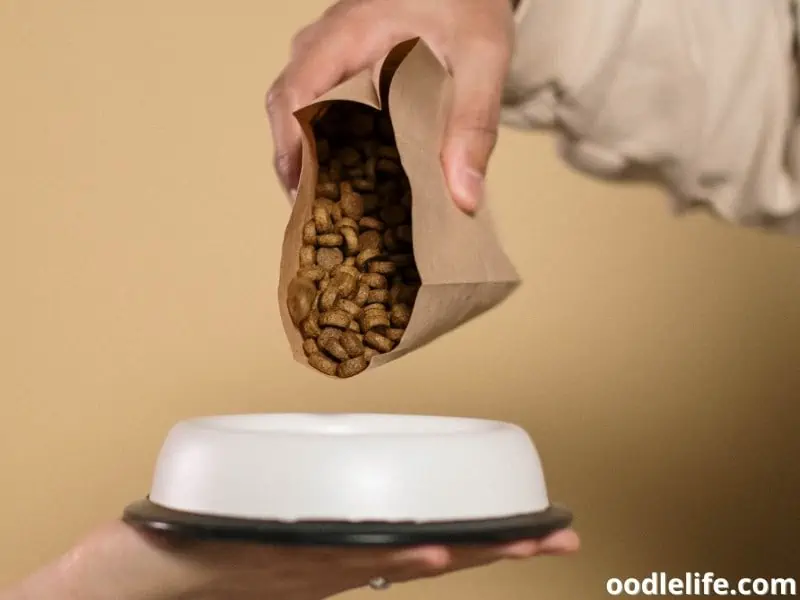
Remember that golden rule, “you are what you eat”? Well, it applies to dogs too.
Exercise
As the wise Forrest Gump once said, “exercise is just like a box of chocolates, you never know what you’re gonna get” – wait, that doesn’t sound right. Well, anyway, exercise is vital for a Vizsla’s growth, strength, and overall health. Ensuring your pup gets enough physical activity through daily walks, jogging, and other forms of exercise is essential.
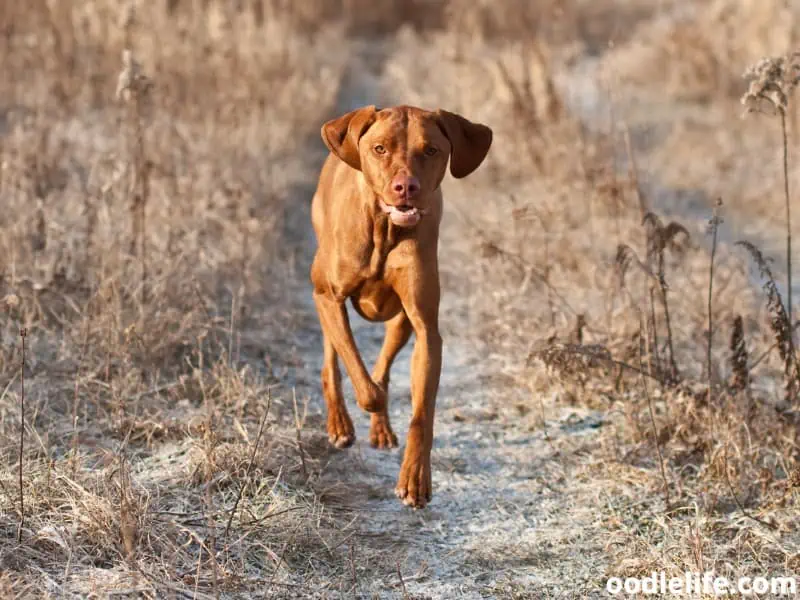
Just make sure not to overdo it, as excessive exercise can cause strain on their growing bones.
Environment
Last but not least, a Vizsla’s growth can be influenced by their environment. The socialization period and neonatal period are critical times for their development, with experiences during these times affecting their growth. Providing a safe and nurturing environment is essential, as stress during the fear stage can negatively impact their growth.

So, put on that favorite jazz record, light a soothing candle (but, please, keep it out of reach), and create a Zen space for your Vizsla to grow and thrive.
Vizsla Size and Weight
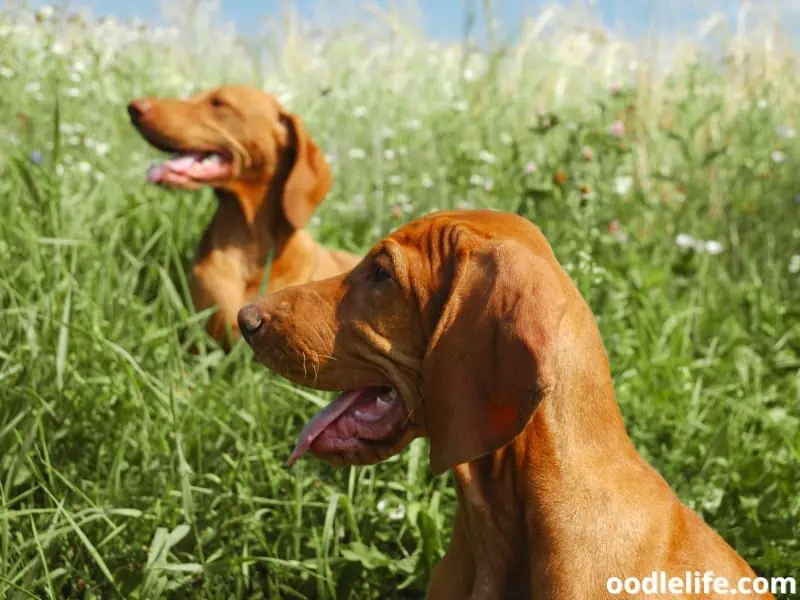
Height and Weight Differences between Males and Females
Vizslas, also known as Hungarian Pointers, are a medium-sized dog breed. Male Vizslas tend to be larger than their female counterparts. Adult males typically stand between 22 to 24 inches tall at the shoulder and weigh between 55 to 65 pounds, while adult females usually measure between 21 to 23 inches in height and weigh between 45 to 55 pounds.
Keeping track of your Vizsla’s growth can help ensure they’re developing properly and maintaining a healthy weight.
Vizsla Weight Chart
It’s essential to monitor your Vizsla’s size and weight as they grow, so let’s take a look at a Vizsla weight chart by age.
| Age | Male Weight (lbs) | Female Weight (lbs) |
|---|---|---|
| 8 weeks | 12 – 16 | 11 – 14 |
| 12 weeks | 18 – 25 | 16 – 22 |
| 4 months | 24 – 35 | 21 – 30 |
| 6 months | 35 – 55 | 30 – 40 |
| 12 months | 45 – 65 | 35 – 55 |
| 24 months | 55 – 65 | 45 – 55 |
Bear in mind that these numbers are just approximate, and individual Vizslas might differ slightly.
Determining Your Vizsla’s Healthy Weight
As a Vizsla owner, it’s essential to keep an eye on your dog’s weight. A healthy Vizsla should have a sleek, muscular body without visible ribs or spinal vertebrae but also shouldn’t have any excess fat.
Here’s a quick method to determine if your Vizsla is at the right weight:
- Run your hand along their side, lightly placing your fingers on their ribcage. You should be able to feel the ribs under a thin layer of fat.
- Look at your Vizsla from the side. A well-proportioned Vizsla will have a slight tuck in the belly, with the waist appearing narrower than the chest and hips.
Remember, maintaining a healthy weight throughout your Vizsla’s life can help prevent joint issues and conditions like progressive retinal atrophy. So, keep a close eye on those scales and make sure they’re getting plenty of exercise to stay fit and healthy!
Health and Development
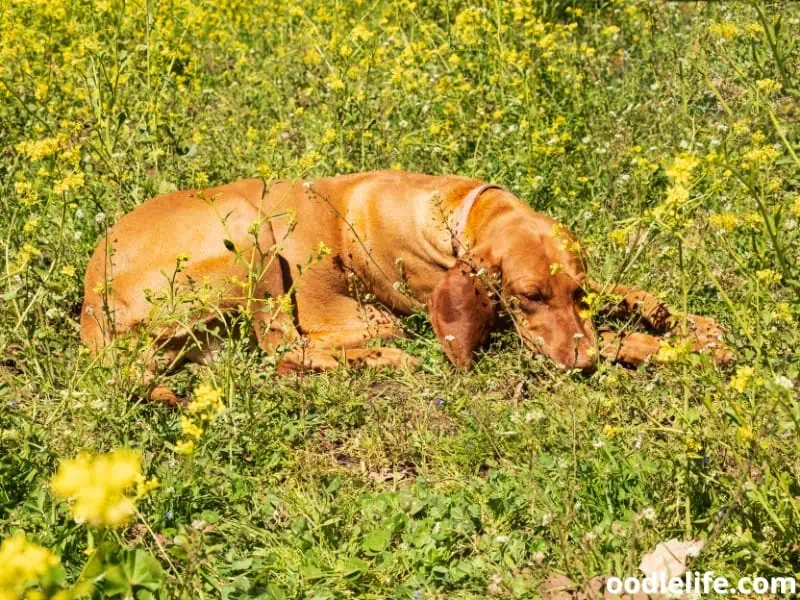
Common Vizsla Health Issues
Hungarian Vizslas are generally healthy dogs, but they may face some common health issues during their development. For example, hip dysplasia is a known condition in the breed, which affects their joints and overall mobility. Another concern is idiopathic inflammatory polymyopathy, a condition more specific to Vizslas, impacting their muscles (source: ‘Clinical features of idiopathic inflammatory polymyopathy in the Hungarian Vizsla’).
Keeping an eye on these potential issues and addressing them promptly will ensure your Vizsla stays in great health.
Bone and Joint Development
As medium-sized dogs, Vizslas typically reach their full height and adult size around one to two years of age. This development can vary depending on the individual and factors such as genetics, diet, and exercise. During this period, it is crucial to watch out for signs of joint or bone pain, as their bones and joints are growing rapidly and sometimes more susceptible to injury.
Proper nutrition and appropriate exercise will help promote healthy bone and joint development in your Vizsla.
Vaccination and Deworming
During the neonatal and transitional periods, Vizslas are toothless and blind, making them particularly vulnerable to health problems. As they grow and enter their sexual maturity, it’s essential to keep them up to date with vaccinations and deworming medications to protect against common diseases and ensure a long, healthy lifespan.
A quick tip for new Vizsla parents: don’t panic if your pup seems deaf; Vizslas’ hearing develops over time, and they’ll soon be attuned to their surroundings.
Now, we all know that “an ounce of prevention is worth a pound of cure.” That’s why scheduling regular vet check-ups, keeping an eye on potential health concerns, and having a solid preventive care plan in place will make sure your Vizsla fits right into your family like a camouflaged ninja (they do blend quite well with couches, don’t they?).
Remember, your Vizsla isn’t just a dog; they’re part of your family, and keeping them healthy is as important as keeping yourself healthy. So, raise a (water) bowl to long-lasting health and endless days of playing fetch with your furry companion!
Training and Socialization

Obedience Classes
Vizslas, being a medium-sized dog breed, are smart and energetic. They reach their maturity period at around 1 to 2 years old. Obedience classes are essential for them to learn basic commands and curb their natural hunting instincts towards rodents, birds, snakes, and other reptiles.
A well-trained Vizsla can be both a good watchdog and a companion. Enrolling them in obedience classes early in their growth helps establish a strong foundation for a well-behaved adult dog.
Home Training
Besides formal obedience classes, home training is equally important. Start with teaching your Vizsla basic commands like “sit,” “stay,” and “come.” Consistency, patience, and positive reinforcement are key to success in home training.
Allocate time for daily training sessions and make sure to give them adequate exercise to help channel their energy in a positive direction. Remember, a bored Vizsla can become a destructive one!
Socializing with Litter Mates
Socializing your Vizsla with their littermates is vital in developing essential social skills and bite inhibition. During their early months, puppies tend to be more receptive to learning how to interact with their fellow dogs. Scheduling regular playdates with their littermates will help in building their confidence and avoiding aggression issues later on.
Bonding with Family Members
A Vizsla is a family-oriented breed, and they form strong bonds with their human family members. Involve everyone in the training and socialization process, allowing the dog to develop comfort and familiarity as they grow. By doing so, you are sure to end up with a loyal and loving watchdog that looks forward to cuddling with the entire family after a long day of exercise and play.
Remember, it’s essential to keep the training and socialization process fun and engaging for both you and your Vizsla. After all, a happy Vizsla makes for a happy household.
Additional Considerations
Reputable Breeders
When looking to welcome a Vizsla into your life, it’s crucial to find a reputable breeder. These breeders prioritize the dogs’ health, temperament, and breed standards. They will provide essential information regarding the puppy’s birth, lineage, and potential growth patterns.

Remember, a well-bred Vizsla will mature into a healthy and well-adjusted adult, so choose wisely.
Therapy Dogs and Dog Sports
Vizslas are incredibly versatile dogs with the ability to excel in various roles, such as therapy dogs and dog sports. In a therapy setting, their gentle demeanor and affectionate nature make them excellent companions for those in need of emotional support or assistance. Additionally, Vizslas thrive in dog sports like agility, obedience, and flyball, showcasing their athleticism and intelligence.
So, while watching your Vizsla grow, consider exploring these fulfilling activities together.
Vizslas as Hunting Dogs
Traditionally bred as pointers and retrievers, Vizslas make exceptional hunting dogs. Their keen senses, strong work ethic, and adaptability allow them to excel in various hunting scenarios. As your Vizsla matures and reaches full size, exposing them to hunting or retrieving activities may enhance their natural instincts, providing mental and physical stimulation.
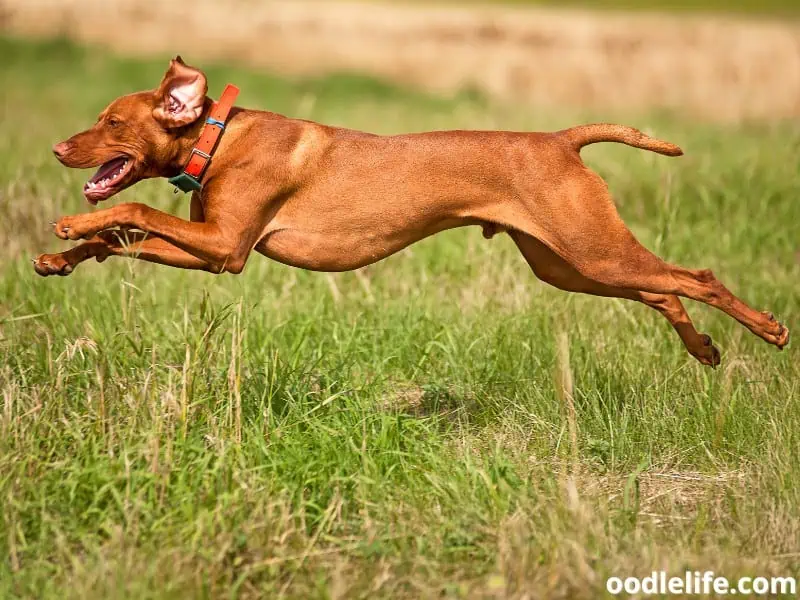
Just be prepared for a determined canine companion ready to make you proud on the field.
Family Members
Lastly, the Vizsla is known for being a fantastic family member. Their friendly and affectionate nature makes them perfect for households with or without children. As your Vizsla grows into a full-sized adult, their love and loyalty to your family will only grow stronger.
So, while keeping their growth and development in mind, don’t forget to cherish the unconditional love and companionship that makes the Vizsla a true asset to your family.
Frequently Asked Questions
When do Vizsla growth plates close?
Vizslas’ growth plates typically close around 12 to 18 months of age. This is the period where their bones stop growing, and they reach their full adult size. Keep in mind that every dog is unique, so some Vizslas may reach their full size earlier or later than others.
At what age do Vizslas calm down?
Vizslas, like many energetic breeds, tend to mellow out as they grow older. Generally, they begin to calm down around 2 to 3 years of age. While they will always have a playful, energetic nature, their energy levels may decrease, making them a bit more manageable.
What is the average female Vizsla weight in kg?
The average weight of a female Vizsla ranges between 18 to 25 kg (40 to 55 pounds). Keep in mind that each dog is unique and their weight can vary based on factors such as genetics, diet, and exercise habits.
What is the standard Vizsla size and weight in kg?
Standard Vizslas have a height range of 53 to 64 cm (21 to 25 inches) at the shoulder. Males typically weigh between 20 to 30 kg (45 to 66 pounds), while females weigh about 18 to 25 kg (40 to 55 pounds).
Why might a Vizsla be smaller than average?
A Vizsla might be smaller than average for several reasons, including genetics, nutrition, health issues, or early-life factors. If you have concerns about your Vizsla’s size, it’s best to consult with a veterinarian to ensure there are no underlying health issues and that your dog’s nutritional needs are being met.
How can I estimate my Vizsla’s weight?
One way to estimate your Vizsla’s weight is to use a dog weight chart or online dog weight calculator. These tools factor in your dog’s breed, age, and current weight to provide an estimate of their adult weight. However, it’s important to remember that these tools are just guidelines and can’t account for individual differences.
Another method is to observe your dog’s physical appearance – they should have a visible waistline and a tucked-in abdomen. If you’re unsure or concerned about your Vizsla’s weight, it’s best to consult with your veterinarian for a more accurate assessment.